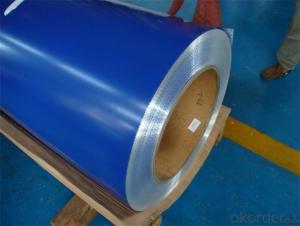Prepainted Rolled Steel Coil for construction Roofing
- Loading Port:
- Shanghai
- Payment Terms:
- TT or LC
- Min Order Qty:
- 25 m.t.
- Supply Capability:
- 30000 m.t./month
OKorder Service Pledge
OKorder Financial Service
You Might Also Like
Structure of Prepainted Rolled steel Coil for Construction Roofing
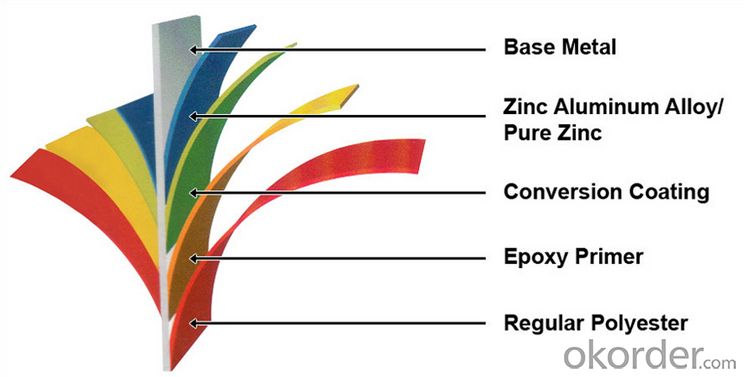
Description of Prepainted Rolled steel Coil for Construction Roofing
Prepainted Rolled steel Coil is a kind of coated steel coil/sheet. With the cold rolled steel of different strength and thickness as substrate, it is produced through applying Al-Zn coat on both faces by hot dip process. In its coating, Al accounts for about 55%, Si 1.6%, while the remaining is Zn. Aluminum zinc coils enjoys both the physical protective feature and durability of Al and the electrochemical protective property of Zn. And its surface has bright silver color and regular embossed-like figure, which are highly decorative.

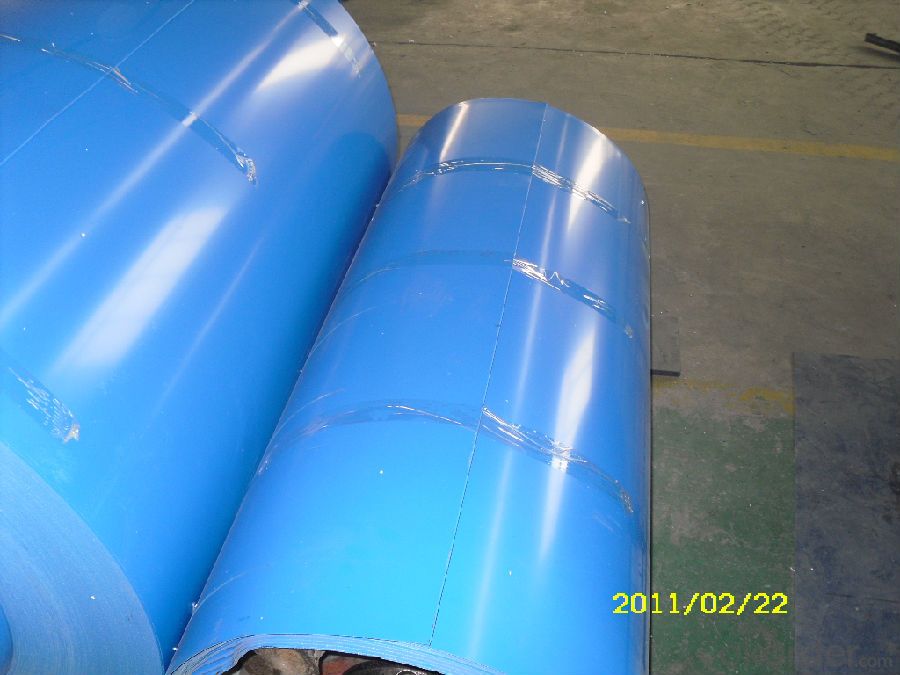
Main Feature of Prepainted Rolled steel Coil for Construction Roofing
1.Corrosion resistance: It mainly depends on the aluminum protection. When the zinc being worn, the aluminum will form a dense layer of aluminum oxide, resist corrosion material to prevent further corrosion inside.
2. Heat resistance: Aluminum zinc alloy steel sheet has excellent heat resistance, can withstand high temperatures over 300 centigrade, and is similar with aluminized steel high temperature oxidation resistance. It often used in chimney pipes, ovens, fluorescent lighting device and the device cover.
3. Heat reflective: Galvanized steel plate heat-reflective high rate is twice as galvanized steel, often used to make insulation materials.
4. Economy: Because density of 55% AL-Zn is smaller than the density of Zn, so in the same weight and thickness of Galvanized zinc layer, aluminum-zinc steel plate is larger area more than 3% of galvanized steel sheet.
Applications of Prepainted Rolled steel Coil for Construction Roofing
1. Construction and building: roofing; ventilating duct; handrail; partition panel;etc.
2. Electric appliance: refrigerator; washing machine; refrigerator; DVD;etc.
3.Transportation: oil tank; road sign; etc.
4.Agriculture:barn; etc.
5.Others:vending machine; game machine; etc.
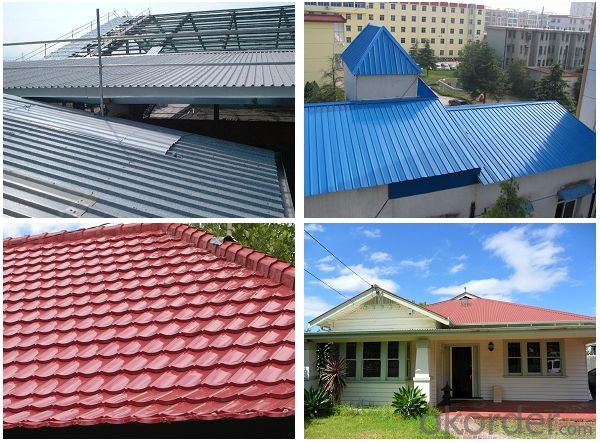
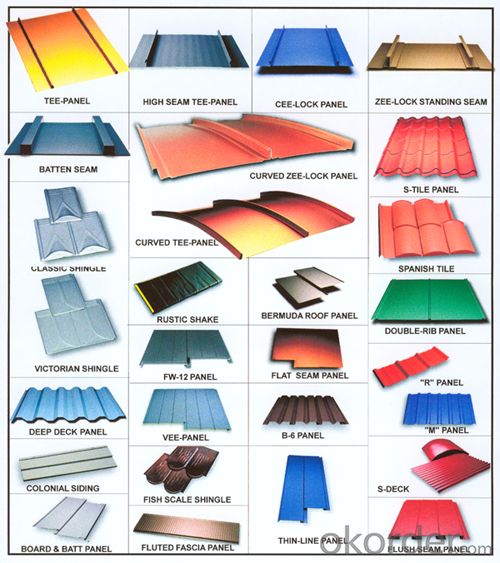
Specifications of Rolled steel Coil for Construction Roofing
Product | Prepainted Rolled steel Coil for Construction Roofing |
Material Grade | SGCC / SGCH / DX51D+AZ, etc |
Thickness | 0.2-3.0mm |
Width | 600-1500mm |
Tolerance | Thickness: +/-0.02mm , Width:+/-2mm |
Zinc-coating | AZ40-150g/m2 |
Technique | Raw material: Hot rolled steel coil --> Cold rolled_>hot dipped galvalume |
Surface | Dried, Chromated, Unoiled |
Spangle | Regular spangle , small spangle, zero spangle |
ID | 508MM |
Coil weight | 10MT max |
Export package | Cardboard inner sleeves, Waterproof paper, galvanized steel covered and steel strip packed |
FAQ of Prepainted Rolled steel Coil for Construction Roofing
We have organized several common questions for our clients,may help you sincerely:
1. What is the minimum order quantity ?
Our MOQ is 50mt for each size. And we will consider to give more discount if you make big order like 1000 tons and more. Further more, the more appropriate payment term your offer the better price we can provide.
2. How long can we receive the product after purchase?
Usually within thirty working days after receiving buyer’s advance payment or LC. We will arrange the factory manufacturing as soon as possible. The cargo readiness usually takes 15-25 days, but the shipment will depend on the vessel situation.
3. How to guarantee the quality of the products?
We have established the international advanced quality management system,every link from raw material to final product we have strict quality test;We resolutely put an end to unqualified products flowing into the market. At the same time, we will provide necessary follow-up service assurance.
- Q:How are steel coils inspected for color consistency?
- Steel coils are inspected for color consistency through visual inspection by trained personnel. They compare the color of the coils against a color standard to ensure uniformity and consistency across the entire batch.
- Q:What are the different coil slitting methods used for steel coils?
- Steel coils can be slit into smaller, narrower coils using various methods. These methods serve the purpose of cutting the coils to suit specific applications. 1. The most commonly used method for coil slitting is blade slitting. Circular knives or blades are employed to cut the steel coil into narrower strips. These blades are placed at predetermined intervals and usually attached to a rotating shaft. As the coil passes through the blades, their circular motion slices through the coil, resulting in the desired narrower strips. 2. Another method, known as rotary shear slitting, involves the use of two sets of rotary shear knives to cut the steel coil. These upper and lower sets of knives rotate in opposite directions, creating a scissor-like cutting action. As the coil is fed through the shearing blades, the sharp edges of the knives slice through the coil, producing the desired narrower strips. 3. Sliding shear slitting is yet another method utilized for coil slitting. This method involves a stationary upper knife and a moving lower knife to cut the coil. The lower knife moves back and forth across the coil while the upper knife remains fixed. As the coil passes through the moving knife, it is cut into narrower strips. 4. Crush slitting is a less common method employed for coil slitting. In this method, the steel coil is fed through a set of rollers equipped with blades. Although the blades are not sharp, the pressure exerted by the rollers crushes and fractures the coil, resulting in the creation of the desired narrower strips. 5. Laser slitting is a modern and precise method used for coil slitting. It utilizes a laser beam to cut through the steel coil. The laser beam is directed onto the coil, and its high intensity melts and vaporizes the steel, creating a narrow slit. Laser slitting offers high accuracy and a clean cut, making it suitable for specialized applications. Each of these coil slitting methods possesses its own advantages and limitations. The choice of method depends on factors such as the type of steel, desired strip width, production volume, and required precision. Manufacturers select the most suitable method based on their specific requirements and the properties of the steel coils they are processing.
- Q:What metals contain steel? It can be anything except soft iron or steel.
- tricky situation. look from google. it may help!
- Q:This needs to be in a percentage by mass. Could you please also reference where this info has come from. Thanks.
- pl. be specific about the type of steel: (Steel is a metal alloy whose major component is iron, with carbon content between 0.02% and 1.7% by weight. Carbon is the most cost effective alloying material for iron, but many other alloying elements are also used.[1] Carbon and other elements act as a hardening agent, preventing dislocations in the iron atom crystal lattice from sliding past one another. Varying the amount of alloying elements and their distribution in the steel controls qualities such as the hardness, elasticity, ductility, and tensile strength of the resulting steel. Steel with increased carbon content can be made harder and stronger than iron, but is also more brittle. The maximum solubility of carbon in iron is 1.7% by weight, occurring at 1130° Celsius; higher concentrations of carbon or lower temperatures will produce cementite which will reduce the material's strength. Alloys with higher carbon content than this are known as cast iron because of their lower melting point.[1] Steel is also to be distinguished from wrought iron with little or no carbon, usually less than 0.035%. It is common today to talk about 'the iron and steel industry' as if it were a single thing; it is today, but historically they were separate products. Currently there are several classes of steels in which carbon is replaced with other alloying materials, and carbon, if present, is undesired. A more recent definition is that steels are iron-based alloys that can be plastically formed (pounded, rolled, etc.). Iron alloy phases : Austenite (γ-iron; hard) Bainite Martensite Cementite (iron carbide; Fe3C) Ferrite (α-iron; soft) Pearlite (88% ferrite, 12% cementite) Types of Steel : Plain-carbon steel (up to 2.1% carbon) Stainless steel (alloy with chromium) HSLA steel (high strength low alloy) Tool steel (very hard; heat-treated) Other Iron-based materials : Cast iron (2.1% carbon) Wrought iron (almost no carbon) Ductile iron)
- Q:What are the dimensions of steel coils used in the appliance industry?
- The dimensions of steel coils used in the appliance industry can vary depending on the specific application and requirements. However, the most common dimensions for steel coils used in the appliance industry are typically around 0.015 to 0.035 inches (0.38 to 0.89 millimeters) in thickness, 24 to 36 inches (61 to 91 centimeters) in width, and weighing between 1,500 to 10,000 pounds (680 to 4,535 kilograms). These dimensions allow for efficient handling, transportation, and processing of the steel coils in the appliance manufacturing process. It is important to note that these dimensions can vary and should be confirmed with the specific manufacturer or supplier for accurate and up-to-date information.
- Q:What are the different types of steel coil surface finishes?
- The different types of steel coil surface finishes include mill finish, hot rolled pickled and oiled (HRPO), cold rolled, galvanized, and coated finishes such as zinc or paint.
- Q:Can steel coils be coated with anti-corrosive substances?
- Yes, steel coils can be coated with anti-corrosive substances such as zinc, paint, or polymer coatings to protect them from rust and corrosion. These coatings act as a barrier between the steel surface and the surrounding environment, preventing contact with moisture and corrosive elements.
- Q:What are the common quality issues with steel coils?
- Some common quality issues with steel coils include: 1. Surface defects: Steel coils may have surface defects such as scratches, pits, or rust spots. These defects can affect the appearance and smoothness of the final product and may also impact its performance. 2. Dimensional variations: Steel coils may exhibit dimensional variations, such as thickness variations, width variations, or length variations. These variations can lead to difficulties in processing the steel and may result in inconsistent product dimensions. 3. Mechanical properties: Steel coils may have variations in mechanical properties such as yield strength, tensile strength, or hardness. These variations can affect the strength and durability of the final product and may also impact its suitability for specific applications. 4. Coating issues: Steel coils that are coated or galvanized may experience issues with the coating, such as uneven coverage, peeling, or adhesion problems. These coating issues can result in reduced corrosion resistance and compromised aesthetics. 5. Internal defects: Steel coils may have internal defects such as inclusions, voids, or segregations. These defects can weaken the steel and may lead to failure or breakage during processing or use. 6. Edge issues: Steel coils may have edge defects, such as burrs, cracks, or uneven edges. These edge issues can affect the handling and processing of the steel and may also lead to problems during fabrication or assembly. 7. Coil set or camber: Steel coils may exhibit coil set or camber, which refers to the curvature or bowing of the coil. This can result in difficulties during processing and may lead to distorted or misaligned products. To ensure the quality of steel coils, manufacturers employ various quality control measures such as rigorous inspection, testing, and adherence to industry standards and specifications.
- Q:How are steel coils processed for different levels of hardness?
- Different levels of hardness can be attained in steel coils using a variety of methods. One common approach is heat treatment, in which the coils are heated to a specific temperature and then rapidly cooled to modify their microstructure and achieve the desired hardness. The heat treatment process can encompass quenching, tempering, or annealing, depending on the desired hardness level. Quenching involves quick cooling of the coils in a liquid medium like water or oil to achieve a high hardness level. On the other hand, tempering requires reheating the coils to a lower temperature and gradually cooling them to attain a desired balance between hardness and toughness. Annealing, on the other hand, involves heating the coils to a specific temperature followed by slow cooling to release internal stresses and obtain a softer and more malleable material. Additionally, mechanical processes like cold rolling or cold working can be employed to enhance the hardness of steel coils. These processes involve applying compressive forces to the coils, causing the material to deform and resulting in increased hardness. Overall, achieving different hardness levels in steel coils requires meticulous control of temperature, cooling rate, and mechanical forces to obtain the desired properties for specific applications.
- Q:What are the common methods of testing the durability of steel coils?
- Steel coils undergo various testing methods to assess their durability, strength, and resistance to different stresses and conditions. Some commonly used techniques include: 1. Tensile testing: This method measures the maximum stress a coil can bear before breaking or deforming by subjecting it to tension. It provides valuable insights into the strength and ductility of steel coils. 2. Bend testing: This method evaluates the flexibility and resistance to deformation of steel coils by bending them to a specific angle and checking for cracks or fractures. It is essential for assessing coil durability in industries like construction or automotive. 3. Impact testing: This method determines the ability of steel coils to withstand sudden shocks or impacts. It involves striking the coil with a heavy object and measuring energy absorption or deformation. Impact testing helps identify coil toughness and resistance to sudden loading conditions. 4. Corrosion testing: Steel coils often face corrosive environments like moisture or chemicals. Corrosion testing examines the resistance of steel to degradation caused by these agents. Salt spray or electrochemical testing simulates and evaluates coil durability in corrosive conditions. 5. Fatigue testing: This method assesses the ability of steel coils to endure repeated loading and unloading cycles. It subjects the coil to cyclic stresses until failure. Fatigue testing is crucial in machinery or infrastructure applications where coils experience repetitive loading. 6. Hardness testing: This method gauges the resistance of steel coils to indentation or scratching, providing information about their strength and wear resistance. Common hardness tests include Brinell, Rockwell, and Vickers methods. 7. Non-destructive testing: In addition to the destructive methods mentioned above, non-destructive techniques like ultrasonic testing, magnetic particle inspection, or X-ray testing are used to detect internal defects or flaws without damaging the coil. By utilizing these testing methods, manufacturers and industries can ensure that steel coils meet the required durability standards and perform reliably in their intended applications.
1. Manufacturer Overview |
|
|---|---|
| Location | |
| Year Established | |
| Annual Output Value | |
| Main Markets | |
| Company Certifications | |
2. Manufacturer Certificates |
|
|---|---|
| a) Certification Name | |
| Range | |
| Reference | |
| Validity Period | |
3. Manufacturer Capability |
|
|---|---|
| a)Trade Capacity | |
| Nearest Port | |
| Export Percentage | |
| No.of Employees in Trade Department | |
| Language Spoken: | |
| b)Factory Information | |
| Factory Size: | |
| No. of Production Lines | |
| Contract Manufacturing | |
| Product Price Range | |
Send your message to us
Prepainted Rolled Steel Coil for construction Roofing
- Loading Port:
- Shanghai
- Payment Terms:
- TT or LC
- Min Order Qty:
- 25 m.t.
- Supply Capability:
- 30000 m.t./month
OKorder Service Pledge
OKorder Financial Service
Similar products
New products
Hot products
Related keywords
